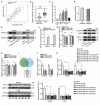LncRNA CASC21 induces HGH1 to mediate colorectal cancer cell proliferation, migration, EMT and stemness
- PMID: 34375566
- PMCID: PMC8677029
- DOI: 10.1080/15476286.2021.1950464
LncRNA CASC21 induces HGH1 to mediate colorectal cancer cell proliferation, migration, EMT and stemness
Abstract
Colorectal cancer (CRC) is one of the leading causes of cancer-related deaths worldwide. Long non-coding RNAs (lncRNAs) have been increasingly reported to serve vital parts in malignancies including CRC. Although cancer susceptibility 21 (CASC21) has been uncovered to play a part in CRC, its mechanism still needs further explanation. Thus, our study aimed to further explore the influence and mechanism of CASC21 in CRC progression. Quantitative real-time RT-PCR and western blot were performed to detect gene expression; a series of functional assays were performed to investigate the effect of CASC21 on CRC cells; in vivo tumour growth was evaluated via the nude mice xenograft model. The results revealed that CASC21 facilitated CRC cell proliferation, migration, epithelial-mesenchymal transition (EMT) and stemness. In addition, CASC21 was co-expressed with and bound to transcription factor POU5F1B (POU class 5 homeobox 1B). CASC21 recruited POU5F1B to HGH1 promoter to activate the transcription of HGH1 homolog. Also, CASC21 served as a competitive endogenous RNA (ceRNA) to up-regulate HGH1 via endogenously sponging miR-485-5p. Moreover, HGH1 overexpression counteracted the suppression of CASC21 deficiency on CRC tumour growth. In summary, our study indicated that CASC21 enhanced the expression of HGH1 to promote the malignancy of CRC by recruiting POU5F1B and sponging miR-485-5p, suggesting a key role of CASC21 in CRC progression.
Keywords: CASC21; Colorectal cancer; HGH1; POU5F1B; miR-485-5p.
Conflict of interest statement
No potential conflict of interest was reported by the author(s).
Figures








Similar articles
-
LncRNA PVT1 facilitates the growth and metastasis of colorectal cancer by sponging with miR-3619-5p to regulate TRIM29 expression.Cancer Rep (Hoboken). 2024 Jun;7(6):e2085. doi: 10.1002/cnr2.2085. Cancer Rep (Hoboken). 2024. PMID: 38837682 Free PMC article.
-
CASC21, a FOXP1 induced long non-coding RNA, promotes colorectal cancer growth by regulating CDK6.Aging (Albany NY). 2020 Jun 25;12(12):12086-12106. doi: 10.18632/aging.103376. Epub 2020 Jun 25. Aging (Albany NY). 2020. PMID: 32584787 Free PMC article.
-
Long noncoding RNA RP11-757G1.5 sponges miR-139-5p and upregulates YAP1 thereby promoting the proliferation and liver, spleen metastasis of colorectal cancer.J Exp Clin Cancer Res. 2020 Oct 6;39(1):207. doi: 10.1186/s13046-020-01717-5. J Exp Clin Cancer Res. 2020. PMID: 33023613 Free PMC article.
-
Unraveling the function of epithelial-mesenchymal transition (EMT) in colorectal cancer: Metastasis, therapy response, and revisiting molecular pathways.Biomed Pharmacother. 2023 Apr;160:114395. doi: 10.1016/j.biopha.2023.114395. Epub 2023 Feb 15. Biomed Pharmacother. 2023. PMID: 36804124 Review.
-
Unraveling the ncRNA landscape that governs colorectal cancer: A roadmap to personalized therapeutics.Life Sci. 2024 Oct 1;354:122946. doi: 10.1016/j.lfs.2024.122946. Epub 2024 Aug 8. Life Sci. 2024. PMID: 39122108 Review.
Cited by
-
GART Functions as a Novel Methyltransferase in the RUVBL1/β-Catenin Signaling Pathway to Promote Tumor Stemness in Colorectal Cancer.Adv Sci (Weinh). 2023 Sep;10(25):e2301264. doi: 10.1002/advs.202301264. Epub 2023 Jul 13. Adv Sci (Weinh). 2023. PMID: 37439412 Free PMC article.
-
The role of HGH1 in breast cancer prognosis: a study on immune response and cell cycle.BMC Cancer. 2024 Sep 9;24(1):1122. doi: 10.1186/s12885-024-12879-2. BMC Cancer. 2024. PMID: 39251967 Free PMC article.
-
LncRNAs, the Molecules Involved in Communications With Colorectal Cancer Stem Cells.Front Oncol. 2022 Jan 27;12:811374. doi: 10.3389/fonc.2022.811374. eCollection 2022. Front Oncol. 2022. PMID: 35155247 Free PMC article. Review.
-
Prognostic and predictive molecular biomarkers in colorectal cancer.Front Oncol. 2025 Apr 16;15:1532924. doi: 10.3389/fonc.2025.1532924. eCollection 2025. Front Oncol. 2025. PMID: 40308511 Free PMC article. Review.
-
Knockdown of HGH1 in breast cancer cell lines can inhibit the viability, invasion and migration of tumor cells.Cell Adh Migr. 2025 Dec;19(1):1-14. doi: 10.1080/19336918.2024.2442349. Epub 2024 Dec 18. Cell Adh Migr. 2025. PMID: 39691959 Free PMC article.
References
-
- Bray F, Ferlay J, Soerjomataram I, et al. Global cancer statistics 2018: GLOBOCAN estimates of incidence and mortality worldwide for 36 cancers in 185 countries. CA Cancer J Clin. 2018;68(6):394–424. - PubMed
-
- Siegel RL, Miller KD, Jemal A.. Cancer Statistics, 2017. CA Cancer J Clin. 2017;67(1):7–30. - PubMed
-
- Watson AJ, Collins PD. Colon cancer: a civilization disorder. Dig Dis. 2011;29(2):222–228. - PubMed
MeSH terms
Substances
LinkOut - more resources
Full Text Sources
Other Literature Sources
Medical
Research Materials
